Antiparasitic Drugs
Learning Objectives
After studying this chapter, you should be able to
1. Name the ingredients found in common anthelmintics and insecticides.
2. Explain the delivery systems of insecticides.
3. Educate clients about products covered in this chapter.
4. Explain the importance of reading and understanding product labels.
5. Identify the different classes of parasiticides and any contraindications for each particular class.
Key Terms
Anthelmintic
Bots
Ectoparasite
Endoparasite
Helminths
Microfilaria
Nematodes
Organophosphate
Parasitiasis
Parasitosis
Symbiosis
Introduction
Controlling parasites in companion animals is a high priority for veterinary medicine. Some people get squeamish when talking about worms, but once the subject is broached, most clients listen intently to what is being said. Veterinary technicians play an important role in educating clients about the life cycle of parasites and the drugs used to eradicate them, and in explaining how important the health of the public is to veterinary medicine in terms of the removal of those parasites with zoonotic potential. This interaction gets the point across and shows how important it is to keep pets free of parasites.
A formalin-preserved heart infected with Dirofilaria immitis adults provides a great visual aid when the subject of heartworm prevention is discussed. Serum bottles with Toxocara canis or Dipylidium caninum adults also make good visual aids when client education is provided.
Parasites live on this earth in many diverse forms and relationships. Parasites lead a symbiotic life (symbiosis). Five types of symbiotic relationships have been identified: (1) predator–prey, (2) phoresis, (3) mutualism, (4) commensalism, and (5) parasitism (Hendrix, 2006). An example of a predator-prey relationship is that of a hawk that finds, captures, and eats a mouse that is running in a field. The word form phore, from which phoresis is derived, means to carry. An example of phoresis is the bacterium Moraxella bovis, the etiologic agent of infectious bovine keratoconjunctivitis, or pinkeye, being mechanically carried from the eyes of one cow to those of another on the sticky footpads of the face fly, Musca autumnalis (Hendrix, 2006). Mutualism occurs when both members of a symbiotic relationship gain from each other. An example of mutualism is the ciliated protozoa that live in the rumen of a cow. The cow benefits by having bulk and fiber digested more readily, and the ciliates benefit because the rumen provides a warm, liquid environment in which to live. Commensalism is a type of symbiotic relationship in which one symbiont benefits, but the other symbiont is not harmed. An example of commensalism is mistletoe growing in the top of a tree. Lastly, parasitism occurs when one species lives at the expense of another. An example of parasitism is Trichuris vulpis that live in the cecum of the canine.
Sometimes, an animal may harbor a parasite on or within its body that is potentially pathogenic, but the animal does not exhibit any outward signs (i.e., clinical disease) of parasitism. This is known as parasitiasis. If, however, the animal harbors a parasite on or within its body, and injury occurs to the animal because of the parasite, this is known as parasitosis. Parasites living on the outside of an animal’s body are known as ectoparasites (e.g., fleas and ticks), and parasites living on the inside of an animal’s body are known as endoparasites (e.g., canine heartworms). An animal with ectoparasites is said to be infested, and an animal with endoparasites is said to be infected. Sometimes, a parasite may wander from its normal location in the host’s body to another location where it does not normally live. These parasites are said to be aberrant (erratic). Although most veterinary personnel use the lay term given to parasites when speaking with a client, it is also important for veterinary technicians to know the genus and species name of the most common parasites. The Linnaean classification scheme is fundamental in keeping parasites organized (i.e., kingdom, phylum, class, order, family, genus, and species).
Each parasite has its own individual life cycle, which may consist of several stages. Every parasite has at least a definitive host and, depending on the species, may have one or more intermediate hosts. The host that contains the adult (sexually mature) stage of the parasite is known as the definitive host, and the host that contains the immature (not sexually mature) stage of the parasite is known as the intermediate host. Knowing the life cycle of parasites helps veterinarians determine which drugs to use and how many doses will be needed to eradicate the parasite from the host animal’s body.
Some parasites have zoonotic potential. This means they may be transmissible from animals to humans. Veterinary technicians should be familiar with which parasites have this ability so they can properly educate clients. Examples of parasites with zoonotic potential include Toxoplasma gondii, Trichinella spiralis, Ancylostoma caninum, and Toxocara canis (Hendrix, 2006).
The Companion Animal Parasite Council (www.capcvet.org) recommends fecal centrifugation techniques to accurately diagnose endoparasitism. Additionally, the amount of feces collected for evaluation is important and should consist of at least 1 g. The specific gravity of flotation solution is equally important, in that ideally it should be 1.18 to 1.20.
Ectoparasites represent an ongoing problem faced by companion animal and livestock owners. Numerous products are manufactured for the removal of fleas and ticks from an animal’s body. Because so many products are available, veterinary technicians play an important role in educating clients about the effectiveness of each product. Client education is important in the area of ectoparasites because misuse of over-the-counter insecticides can be fatal. Clients should be taught to ask veterinary personnel about the correct use of shampoos, dips, sprays, powders, and topical parasiticides (e.g., fipronil and imidacloprid) before a purchase is made.
Parasitology is a fascinating subject. However, for most clients, it is not fascinating at all because they just want their pet to be free of worms and bugs. It is up to veterinary personnel to have knowledge about available products and to remember that—as technology evolves—lifelong learning must be pursued so that professionals can remain current with how each drug or parasiticide works. Veterinary personnel have a double responsibility because it is up to them to protect both pets and their owners from those parasites with zoonotic potential and to educate clients accordingly. Veterinary medicine truly has a twofold purpose: the medical treatment of animals and protection of the public from health risks associated with zoonotic diseases and parasites. In some ways, veterinary medicine is more important than human medicine when it is considered from this standpoint because it represents the first defense in the protection of human health. Reading package inserts helps veterinary personnel to understand how a particular drug works. Tables 13-1 to 13-9 list products and their uses for various species.
TABLE 13-1
Parasiticides Used for Treatment and Control of Internal Parasites in Dogs and Cats
| PARASITE | ||||||||||
| DRUG | TOXOCARA, TOXASCARIS | ANCYLOSTOMA, UNCINARIA | STRONGYLOIDES | TRICHURIS | DIROFILARIA ADULTS | DIROFILARIA MICROFILARIAE | TAENIA | DIPYLIDIUM | GIARDIA* | COCCIDIA |
| Albendazole | + | + | − | + | − | − | + | − | + | − |
| Amprolium | − | − | − | − | − | − | − | − | − | + |
| Butamisole hydrochloride | − | + | − | + | − | − | − | − | − | − |
| Dichlorophen | − | − | − | − | − | − | + | + | − | − |
| Dichlorophen/toluene | + | + | − | − | − | − | + | + | − | − |
| Dichlorvos | + | + | − | + | − | − | − | − | − | − |
| Diethylcarbamazine | + | − | − | − | − | + | − | − | − | − |
| Epsiprantel | − | − | − | − | − | − | + | + | − | − |
| Febantel | + | + | − | + | − | − | + | − | − | − |
| Febantel/praziquantel | + | + | − | + | − | − | + | + | − | − |
| Fenbendazole | + | + | − | + | − | − | + | − | − | − |
| Furazolidone | − | − | − | − | − | − | − | − | + | − |
| Ivermectin | + | + | − | + | − | + | − | − | − | − |
| Mebendazole | + | + | − | + | − | − | + | − | − | − |
| Melarsomine dihydrochloride | − | − | − | − | + | − | − | − | − | − |
| Metronidazole | − | − | − | − | − | − | − | − | + | − |
| Milbemycin oxime | + | + | − | + | − | + | − | − | − | − |
| N-Butyl chloride | + | + | − | − | − | − | − | − | − | − |
| Nitroscanate | + | + | − | + | − | − | + | + | − | − |
| Oxibendazole/diethylcarbamazine | + | + | − | + | − | + | − | − | − | − |
| Piperazine salts | + | − | − | − | − | − | − | − | − | − |
| Praziquantel | − | − | − | − | − | − | + | + | − | − |
| Praziquantel/pyrantel pamoate | + | + | − | − | − | − | + | + | − | − |
| Praziquantel/pyrantel pamoate/febantel | + | + | − | + | − | − | + | + | − | − |
| Pyrantel pamoate | + | + | − | − | − | − | − | − | − | − |
| Quinacrine hydrochloride | − | − | − | − | − | − | − | − | + | − |
| Selamectin | + | + | − | − | − | + | − | − | − | − |
| Sulfadiazine/trimethoprim | − | − | − | − | − | − | − | − | − | + |
| Sulfadimethoxine | − | − | − | − | − | − | − | − | − | + |
| Thiabendazole | − | − | + | − | − | − | − | − | − | − |
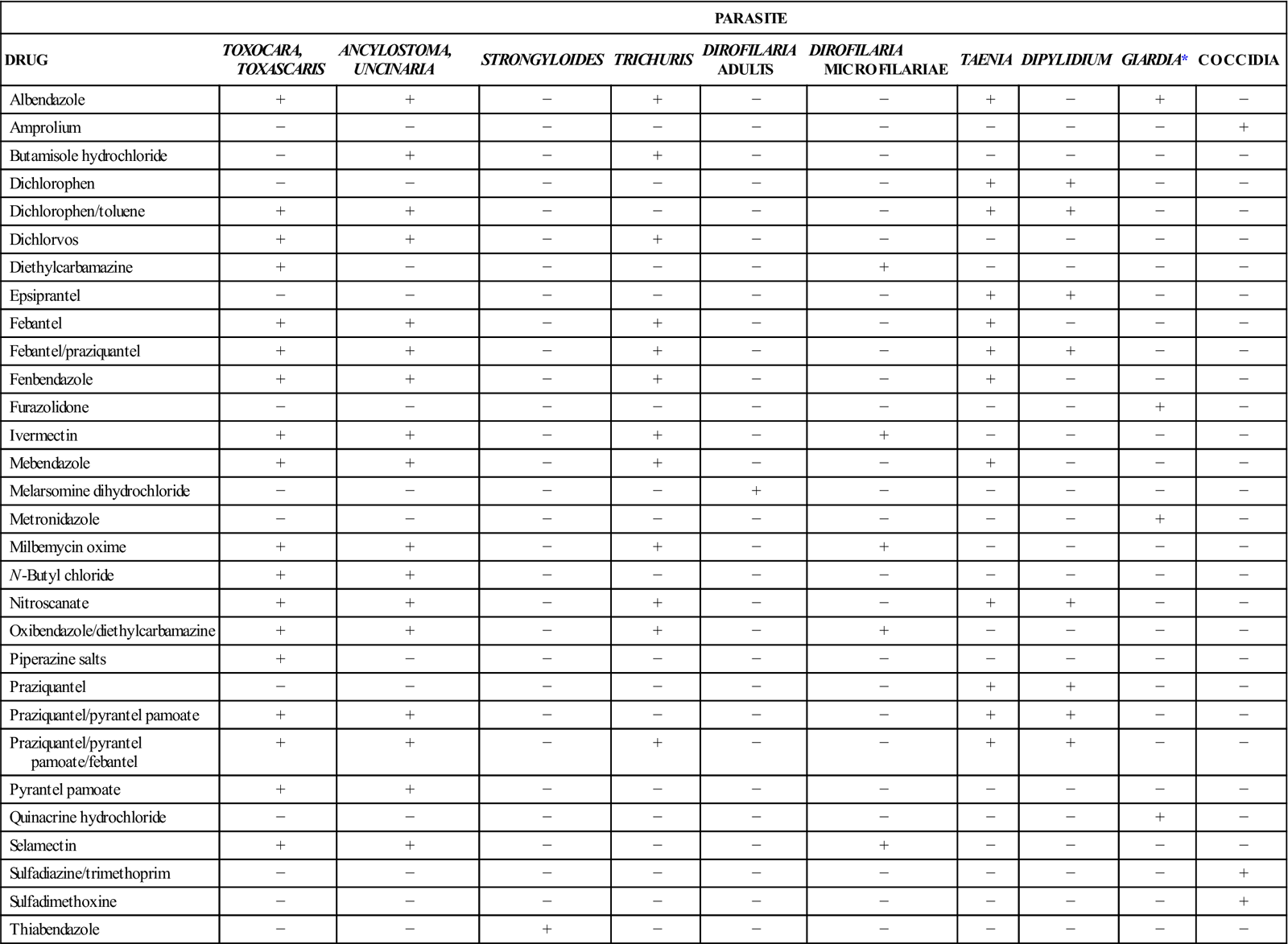
+, Indicated for use; −, not indicated for use.
*Paromomycin, an antibiotic, is being used to manage Cryptosporidium infections and resistant Giardia infections in dogs and cats.
From McCurnin DM, Bassert JM: Clinical textbook for veterinary technicians, ed 5, Philadelphia 2002, WB Saunders.
TABLE 13-2
Parasiticides Used to Treat Internal Parasites in Horses
| PARASITE | |||||||
| DRUG | GASTEROPHILUS | ASCARIDS | STRONGYLUS VULGARIS | STRONGYLUS EDENTATUS | SMALL STRONGYLES | PINWORMS | STRONGYLOIDES |
| Cambendazole | − | + | + | + | + | + | + |
| Dichlorvos | + | + | + | + | + | + | − |
| Febantel | − | + | + | + | + | + | + |
| Fenbendazole | − | + | + | + | + | + | + |
| Ivermectin | + | + | + | + | + | + | + |
| Moxidectin | + | + | + | + | + | + | − |
| Oxibendazole | − | + | + | + | + | + | + |
| Oxfendazole | − | + | + | + | + | + | + |
| Phenothiazine | − | − | + | + | + | − | − |
| Piperazine salts | − | + | − | − | + | + | − |
| Pyrantel salts | − | + | + | − | + | − | − |
| Thiabendazole | − | − | + | + | + | + | + |
| Thiabendazole/piperazine | − | + | + | + | + | + | + |
| Thiabendazole/trichlorfon | + | + | + | + | + | + | + |
| Trichlorfon | + | + | − | − | − | + | − |
| Trichlorfon/phenothiazine/piperazine | + | + | + | − | + | + | − |
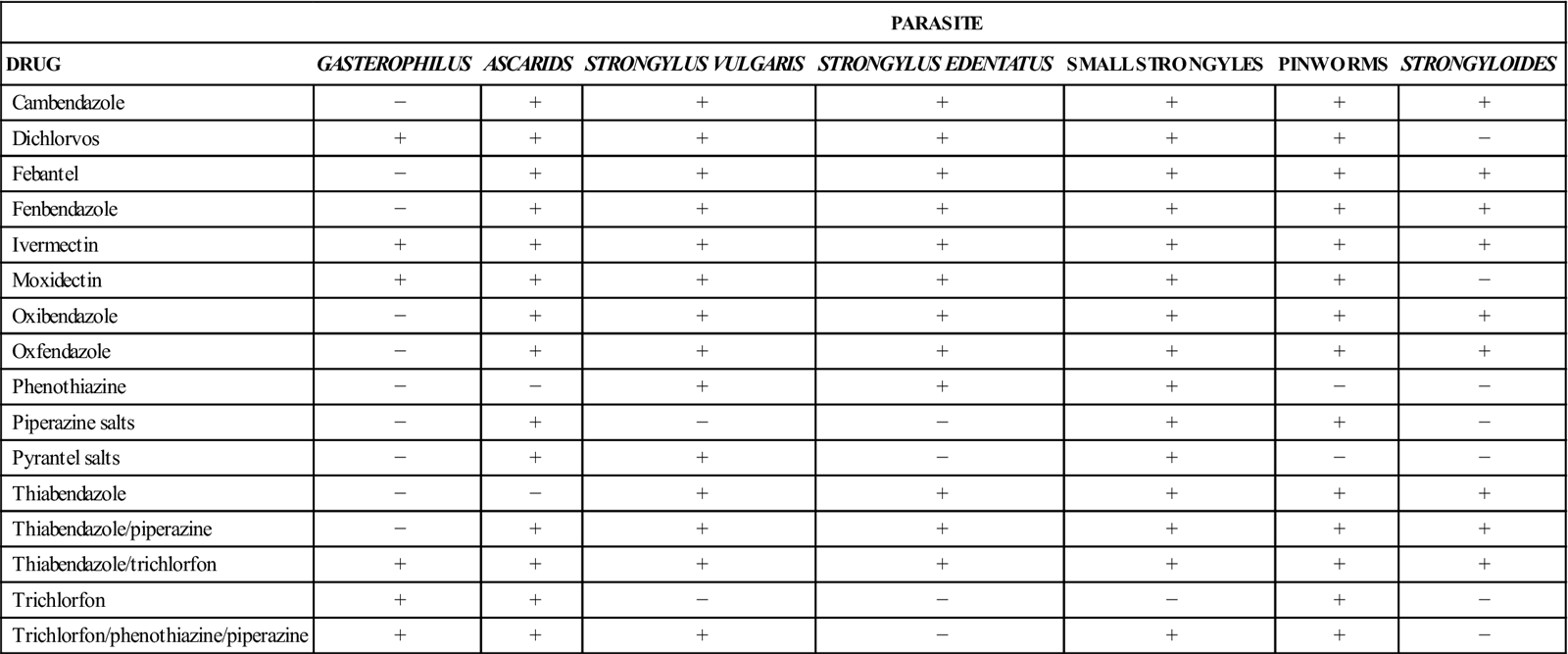
+, Indicated for use; −, not indicated for use.
From McCurnin DM, Bassert JM: Clinical textbook for veterinary technicians, ed 5, Philadelphia, 2002, WB Saunders.
TABLE 13-3
Parasiticides Used to Treat Internal Parasites in Cattle, Sheep, and Goats
| PARASITE | ||||||||||||||
| DRUG | HAEMONCHUS | OSTERTAGIA | TRICHOSTRONGYLUS | COOPERIA | NEMATODIRUS | STRONGYLOIDES | BUNOSTOMUM | TRICHURIS | OESOPHAGOSTOMUM | CHABERTIA | DICTYOCAULUS | MONIEZIA | FASCIOLA | COCCIDIA |
| Albendazole | + | + | + | + | + | − | + | − | + | + | + | + | + | − |
| Amprolium | − | − | − | − | − | − | − | − | − | − | − | − | − | − |
| Clorsulon | − | − | − | − | − | − | − | − | − | − | − | − | + | − |
| Decoquinate | − | − | − | − | − | − | − | − | − | − | − | − | − | + |
| Fenbendazole | + | + | + | + | + | + | + | + | + | + | + | − | − | − |
| Haloxon | + | + | + | + | − | − | − | − | − | − | − | − | − | − |
| Ivermectin | + | + | + | + | + | + | + | − | + | + | + | − | − | − |
| Lasalacid | − | − | − | − | − | − | − | − | − | − | − | − | − | + |
| Levamisole | + | + | + | + | + | + | + | + | + | + | + | − | − | − |
| Moxidectin | + | + | + | + | + | − | + | − | + | − | + | − | − | − |
| Monensin | − | − | − | − | − | − | − | − | − | − | − | − | − | + |
| Morantel tartrate | + | + | + | + | + | + | + | − | + | + | + | − | − | − |
| Phenothiazine | + | + | + | − | − | − | − | − | + | − | − | − | − | − |
| Sulfonamides | − | − | − | − | − | − | − | − | − | − | − | − | − | + |
| Thiabendazole | + | + | + | + | + | + | + | − | + | + | − | − | − | − |

+, Indicated for use; −, not indicated for use.
From McCurnin DM, Bassert JM: Clinical textbook for veterinary technicians, ed 5, Philadelphia, 2002, WB Saunders.
TABLE 13-4
Parasiticides Used to Treat Internal Parasites in Swine
| PARASITE | ||||||||
| DRUG | ASCARIS | STRONGYLOIDES | OESOPHAGOSTOMUM | TRICHURIS | HYOSTRONGYLUS | METASTRONGYLUS | STEPHANURUS | COCCIDIA |
| Dichlorvos | + | − | + | + | + | − | − | − |
| Fenbendazole | + | − | + | + | + | + | − | − |
| Hygromycin B | + | − | + | + | − | − | − | − |
| Ivermectin | + | + | + | − | + | + | + | − |
| Levamisole | + | + | + | − | + | + | + | − |
| Piperazine salts | + | − | − | − | − | − | − | − |
| Pyrantel tartrate | + | − | + | − | − | − | − | − |
| Sulfonamides | − | − | − | − | − | − | − | + |
| Thiabendazole | − | + | + | − | + | − | − | − |

+, Indicated for use; −, not indicated for use.
From McCurnin DM, Bassert JM: Clinical textbook for veterinary technicians, ed 5, Philadelphia, 2002, WB Saunders.
TABLE 13-5
Drugs Used to Treat Internal Parasites in Reptiles
| PARASITE | |||||||
| DRUG | ECTOPARASITES | NEMATODES | TREMATODES | CESTODES | CRYPTOSPORIDIUM | COCCIDIA | AMOEBAE AND TRICHOMONADS |
| Metronidazole (Flagyl) | − | − | − | − | − | − | + |
| Paromomycin (Humatin 400) | − | − | − | − | − | − | + |
| Praziquantel (Droncit) | − | − | + | + | − | − | − |
| Febantel plus Praziquantel (Vercom) | − | + | + | + | − | − | − |
| Dichlorvos (Task) | − | + | − | − | − | − | − |
| Dichlorvos (Vapona Strip) | + | − | − | − | − | − | − |
| Levamisole (Tramisol, Ripercol) | − | + | − | − | − | − | − |
| Thiabendazole (Thibenzole) | − | + | − | − | − | − | − |
| Fenbendazole (Panacur) | − | + | − | − | − | − | − |
| Mebendazole (Telmin) | − | + | − | − | − | − | − |
| Ivermectin* (Ivomec) | + | + | − | − | − | − | − |
| Dithiazanine iodide (Dizan) | − | + | − | − | − | − | − |
| Sulfadiazine (many trade names) | − | − | − | − | − | + | − |
| Sulfamerazine (many trade names) | − | − | − | − | − | + | − |
| Sulfamethazine (many trade names) | − | − | − | − | − | + | − |
| Sulfadimethoxine (Albon) | − | − | − | − | − | + | − |
| Trimethoprim plus Sulfadiazine (Di-Trim, Tribrissen) | − | − | − | − | + | + | − |
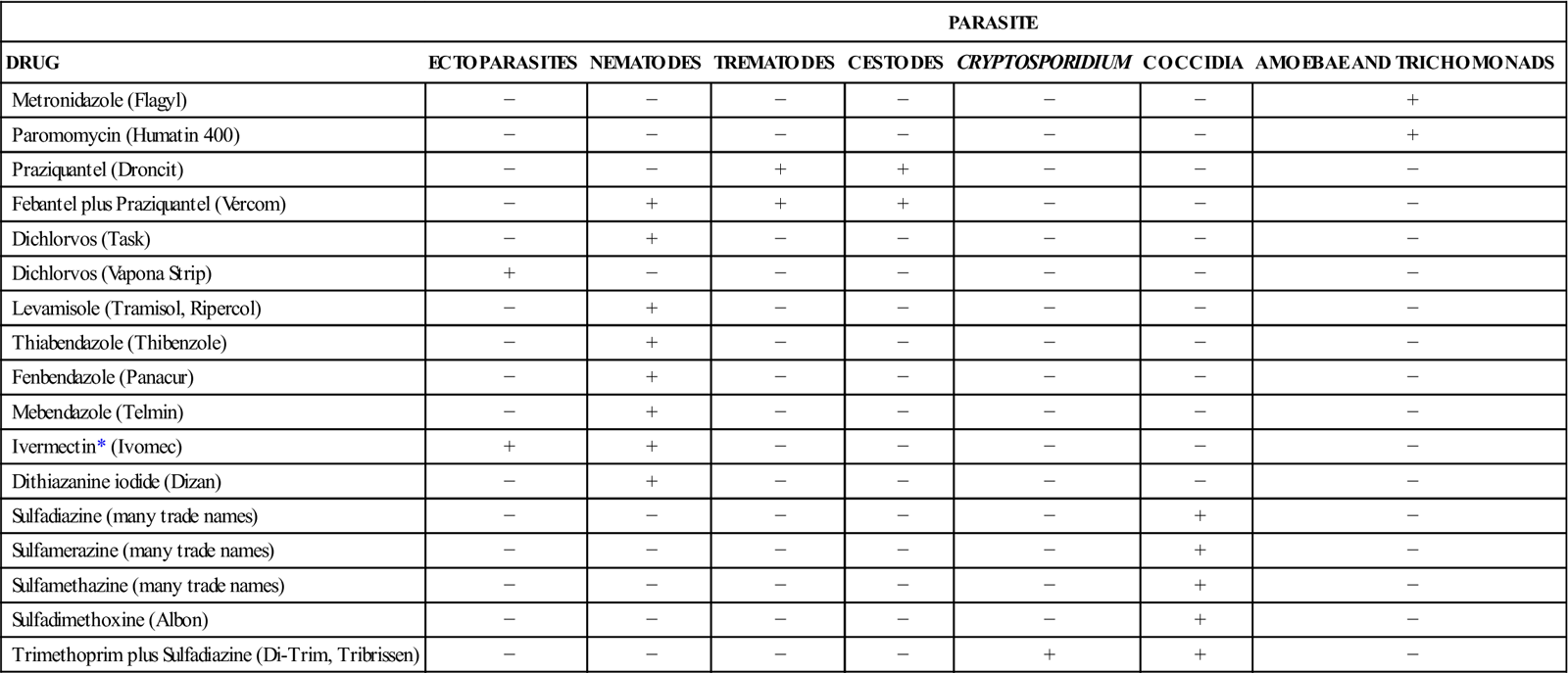
+, Effective; −, not effective.
*Do not use in chelonians. Contraindicated in animals that have been given diazepam or will receive diazepam within 10 days of administration of ivermectin.
Data from Frye FL: Reptile care, Neptune City, NJ, 1991, T.F.H. Publications.
TABLE 13-6
Parasiticides Used for Control of External Parasites on Dogs and Cats
| PARASITE | PARASITE | ||||||||
| DRUG | FLEAS | LICE | MITES | TICKS | DRUG | FLEAS | LICE | MITES | TICKS |
| Allethrin | + | − | − | − | Linalool | + | − | − | − |
| Amitraz | − | − | + | − | Lufenuron | + | − | − | − |
| Carbaril | + | + | + | + | Malathion | + | + | − | + |
| Chlorpyrifos | + | + | + | + | Methylcarbamate | + | + | − | + |
| Cythioate | + | − | − | − | Permethrin | + | + | − | + |
| d-Limonene | + | + | − | − | Phosmet | + | + | + | + |
| Diazinon | + | + | − | + | Pyrethrins | + | + | − | + |
| Fenthion | + | − | − | − | Resmethrin | + | + | − | − |
| Fipronil | + | + | − | + | Rotenone | + | + | − | + |
| Imidacloprid | + | + | − | − | Selamectin | + | − | + | + |
| Lime-sulfur | − | − | + | − | |||||
| Lindane (not legal in United States) | + | + | + | + | |||||
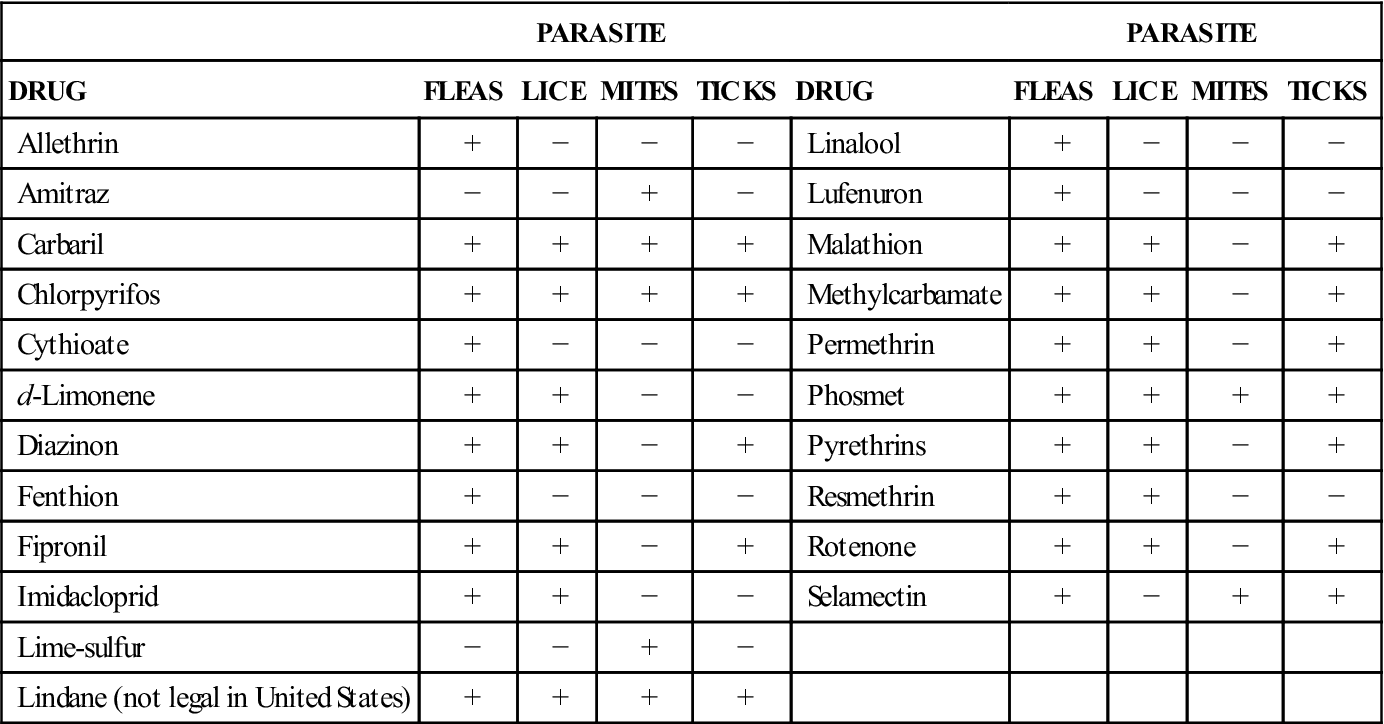
+, Indicated for use; −, not indicated for use.
From McCurnin DM, Bassert JM: Clinical textbook for veterinary technicians, ed 5, Philadelphia, 2002, WB Saunders.
TABLE 13-7
Parasiticides Used for Control of External Parasites on Horses
| PARASITE | |||||
| DRUG | LICE | FLIES | MITES | TICKS | MAGGOTS |
| Coumaphos | + | + | − | + | + |
| Malathion | + | + | + | + | − |
| Permethrin | + | + | − | + | − |
| Pyrethrins | + | + | − | − | − |
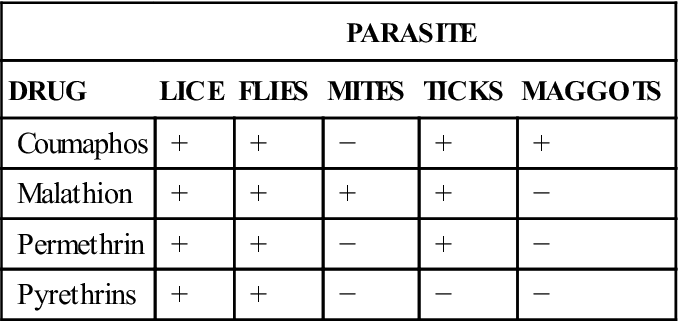
+, Indicated for use; −, not indicated for use.
From McCurnin DM, Bassert JM: Clinical textbook for veterinary technicians, ed 5, Philadelphia, 2002, WB Saunders.
TABLE 13-8
Parasiticides Used for Control of External Parasites on Cattle, Sheep, and Goats
| PARASITE | ||||||||||||
| DRUG | CATTLE GRUB | HORN FLY | FACE FLY | OTHER FLIES | MAGGOTS | CHEWING LICE | SUCKING LICE | PSOROPTIC MITE | OTHER MITES | EAR TICKS | OTHER TICKS | SHEEP KED |
| Carbaril | − | + | + | + | − | + | + | − | − | + | + | − |
| Coumaphos | + | + | + | + | + | + | + | + | − | + | + | + |
| Chlorpyrifos | − | + | − | − | − | + | + | − | − | − | − | − |
| Dichlorvos | − | + | + | + | − | − | − | − | − | − | + | − |
| Famphur | + | − | − | − | − | + | + | − | − | + | + | − |
| Doramectin | − | − | − | − | − | + | + | − | − | − | − | − |
| Fenthion | + | − | − | − | − | + | + | − | − | + | + | − |
| Fenvalerate | − | + | + | − | − | − | − | − | − | + | − | − |
| Ivermectin | + | − | − | − | − | − | + | + | + | + | + | − |
| Methoxychlor | − | + | + | + | − | + | + | − | − | + | + | − |
| Moxidectin | + | + | − | − | − | + | + | + | + | − | − | − |
| Permethrin | − | + | + | − | − | − | − | − | − | − | + | − |
| Phosmet | + | + | − | − | − | + | + | + | + | + | + | − |
| Pyrethrins | − | + | + | + | − | − | − | − | − | − | − | − |
| Rotenone | − | − | − | − | − | + | + | − | − | − | − | + |
| Trichlorfon | + | + | − | − | + | + | + | − | − | + | + | − |
Stay updated, free articles. Join our Telegram channel

Full access? Get Clinical Tree


